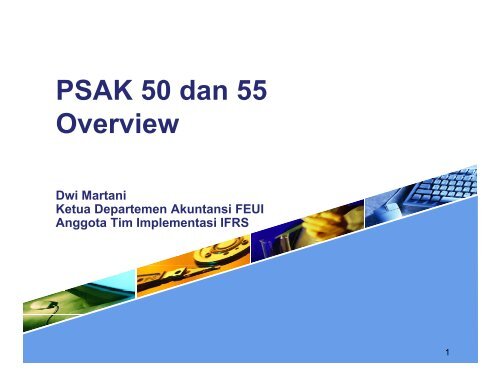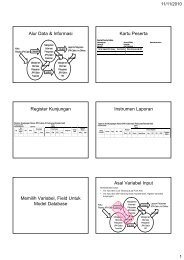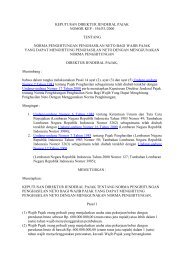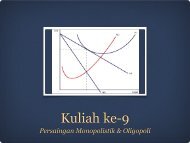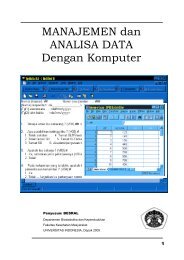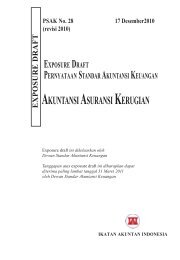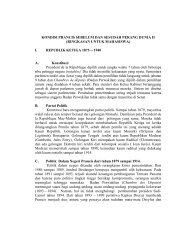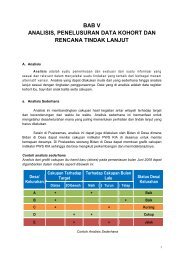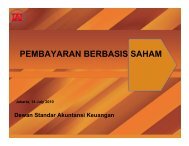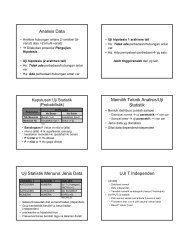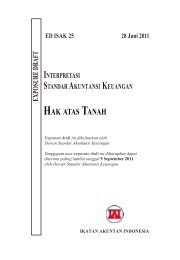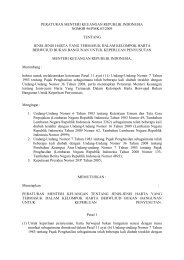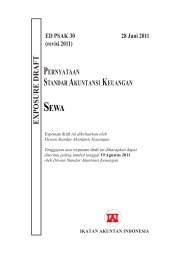PSAK 50 dan 55 Overview - Blog Staff UI
PSAK 50 dan 55 Overview - Blog Staff UI
PSAK 50 dan 55 Overview - Blog Staff UI
Create successful ePaper yourself
Turn your PDF publications into a flip-book with our unique Google optimized e-Paper software.
<strong>PSAK</strong> <strong>50</strong> <strong>dan</strong> <strong>55</strong><br />
<strong>Overview</strong><br />
Dwi Martani<br />
Ketua Departemen Akuntansi FE<strong>UI</strong><br />
Anggota Tim Implementasi IFRS<br />
1
Agenda<br />
1<br />
<strong>Overview</strong> <strong>PSAK</strong> <strong>50</strong> <strong>dan</strong> <strong>55</strong> <strong>dan</strong> perubahanya<br />
2<br />
Definisi<br />
3 Pengakuan, pengukuran, penyajian<br />
4<br />
Ilustrasi <strong>dan</strong> Contoh<br />
2
Instrumen Keuangan <strong>50</strong>,<strong>55</strong>,60<br />
Instrumen Keuangan<br />
IAS 32 IAS 39 IFRS 7<br />
<strong>PSAK</strong> <strong>50</strong> <strong>PSAK</strong> <strong>55</strong> <strong>PSAK</strong> 60<br />
• Definisi <strong>dan</strong> klasifikasi<br />
• Definisi, klasifikasi<br />
• Pemisahan liabilitas<br />
<strong>dan</strong> reklasifikasi<br />
keuangan <strong>dan</strong> ekuitas • Pengakuan <strong>dan</strong><br />
• Akuntansi untuk<br />
penghapusan<br />
instrumen keuangan<br />
majemuk.<br />
• Akuntansi untuk<br />
penarikan saham <strong>dan</strong><br />
saham treasury<br />
• Saling hapus atas aset<br />
<strong>dan</strong> liablitas<br />
• Pengukuran setelah<br />
pengakuan awal<br />
• Akuntansi untuk<br />
derivarif untuk<br />
diperdagangkan <strong>dan</strong><br />
hedging.<br />
• Pengungkapan<br />
instrumen<br />
keuangan <strong>dan</strong><br />
risiko<br />
3
Challenging issues from financial instruments<br />
Distinguishing<br />
between financial<br />
i liability and equity<br />
instrument<br />
Recognition<br />
of “off-balance<br />
sheet” instruments<br />
including executory<br />
contracts<br />
Separation of<br />
embedded<br />
derivatives<br />
Different<br />
accounting<br />
treating for<br />
hedging and<br />
trading<br />
instruments<br />
4
Perbandingan Pengaturan - Transaksi<br />
• <strong>PSAK</strong> <strong>50</strong> (1998):<br />
• Investor<br />
• Investasi dalam efek<br />
tertentu<br />
• Efek utang<br />
• Efek ekuitas<br />
• <strong>PSAK</strong> <strong>55</strong> (1999):<br />
• Investor<br />
• Intrumen derivatif <strong>dan</strong><br />
transaksi lindung nilai.<br />
• Aspek Perlakuan Akuntansi:<br />
• Pengakuan, Pengukuran,<br />
Penyajian <strong>dan</strong><br />
Pengungkapan<br />
• <strong>PSAK</strong> <strong>50</strong> (Rev. 2010):<br />
• Penerbit efek<br />
• Penyajian Kewajiban keuangan<br />
<strong>dan</strong> Ekuitas<br />
• saling hapus aset keuangan<br />
dengan kewajiban keuangan<br />
• Revisi 2010 Puttable instrument<br />
• <strong>PSAK</strong> <strong>55</strong> (Rev.2006):<br />
• Investor/pemilik hak tagih<br />
• Pengakuan <strong>dan</strong> pengukuran<br />
• Instrumen keuangan<br />
– Aset keuangan<br />
– Kewajiban ajba keuangan<br />
• Instrumen derivatif<br />
• Akuntansi lindung nilai<br />
• <strong>PSAK</strong> 60 (Rev.2010):<br />
• Pengungkapan instrumen<br />
keuangan<br />
5
Perbedaan Pengaturan<br />
• Ruang lingkup<br />
• Pengakuan<br />
• Kategori instrumen keuangan<br />
• Fair value option<br />
• Reklasifikasi<br />
• Penurunan nilai<br />
• Penghentian pengakuan<br />
6
<strong>PSAK</strong> <strong>50</strong> R –<br />
Instrumen Keuangan Penyajian<br />
• Skop meliputi seluruh tipe instrumen keuangan<br />
• Definisi detail atas instrumen keuangan : aset<br />
keuangan, liabilitas keuangan <strong>dan</strong> instrumen<br />
ekuitas<br />
• Instrumen ekuitas adalah kontrak yang<br />
memberikan kepada pemegangnya hak residu<br />
atas aset entitas setelah dikurangi dengan semua<br />
liabilitas<br />
• Alokasi nilai buku instrumen keuangan untuk<br />
komponen ekuitas <strong>dan</strong> utang. Nilai utang<br />
ditetapkan terlebih dahulu<br />
7
<strong>PSAK</strong> <strong>50</strong> R –<br />
Instrumen Keuangan Penyajian<br />
• Pembelian saham diperoleh kembali (treasury<br />
stock) dicatat sebagai perubahan atas ekuitas<br />
sehingga tidak ada keuntungan/kerugian yang<br />
diakui<br />
• Termasuk dalam definisi aset <strong>dan</strong> liabilitas<br />
keuangan adalah kontrak yang diselesaikan<br />
dengan instrumen ekuitas suatu entitas.<br />
• Aset <strong>dan</strong> liabilitas keuangan diakui ketika entitas<br />
mengambil bagian dalam suatu kontrak provisi<br />
atas suatu instrumen<br />
8
<strong>PSAK</strong> <strong>50</strong> R (2010) –<br />
Instrumen Keuangan Penyajian<br />
• Semua ketentuan tentang pengungkapan dipindahkan ke<br />
<strong>PSAK</strong> 60 (IFRS 7)<br />
• Tambahan pengaturan khusus tentang :<br />
• puttable instrument , kewajiban untuk menyerahkan bagian aset neto<br />
secara prorata saat likuidasi, <strong>dan</strong> rights, opsi, waran dikategorikan <strong>dan</strong><br />
disajikan sebagai liabilitas keuangan, akan tetapi dapat dikategorikan<br />
sebagai instrumen ekuitas jika memenuhi syarat-syarat tertentu.puttable<br />
instrument<br />
• Instrumen yang mempunyai fitur opsi jual (puttable instrument) adalah<br />
instrumen keuangan yang memberikan hak kepada pemegangnya untuk<br />
menjual kembali instrumen kepada penerbit <strong>dan</strong> memperoleh kas atau<br />
aset keuangan lain atau secara otomatis menjual kembali kepada penerbit<br />
pada saat terjadinya suatu peristiwa yang tidak pasti di masa yang akan<br />
datang atau kematian atau purna karya dari pemegang instrumen.<br />
9
<strong>PSAK</strong> <strong>55</strong> R – Instrumen keungan pengakuan <strong>dan</strong><br />
Pengukuran<br />
► Instrumen keuangan diukur pada pengakuan awal sebesar<br />
nilai wajar ditambah dengan biaya transaksi kecuali untuk<br />
instrumen yang diukur dengan menggunakan nilai wajar.<br />
► Penghapusan (dererecognition) aset keuangan didasarkan<br />
atas kombinasi “risk and reward” <strong>dan</strong> pendekatan<br />
pengendalian. Evaluasi atas risk and reward diakukan<br />
sebelum evaluasi atas transfer pengendalian<br />
► Pengakuan gain/loss atas penghapusan (extinguishment)<br />
liabilitas keuangan ketika utang baru diterbitkan memiliki<br />
persyaratan (term) yang berbeda dengan utang lama.<br />
► Restrukturisasi utang yang menyebabkan modifikasi<br />
substansial term dapat menghasilkan gain/loss pada saat<br />
penerbitan liabilitas baru.<br />
10
<strong>PSAK</strong> <strong>55</strong> R – Instrumen keungan pengakuan <strong>dan</strong><br />
Pengukuran<br />
• Empat kategori aset keuangan:<br />
1. Aset keuangan yang ditetapkan untuk diukur pada nilai wajar<br />
melalui laporan laba rugi;<br />
2. Investasi dimiliki hingga jatuh tempo;<br />
3. Pinjaman yang diberikan atau piutang; <strong>dan</strong><br />
4. Aset keuangan tersedia untuk dijual.<br />
• Dua kategori liabilitas keuangan<br />
1) Kewajiban keuangan yang diukur pada nilai wajar melalui laporan<br />
laba rugi<br />
2) Kewajiban lain<br />
• Pengukuran aset keuangan dengan menggunakan nilai<br />
wajar dalam arti luas<br />
• Beberapa perbedaan dalam praktik dalam mengidentifikasi<br />
derivatif majemuk.<br />
11
<strong>PSAK</strong> <strong>55</strong> R – Instrumen keungan pengakuan <strong>dan</strong><br />
Pengukuran<br />
• Harga pasar atas aset yang dimiliki atau liabilitas yang<br />
akan diterbitkan adalah harga penawaran(bid price) <strong>dan</strong><br />
untuk aset yang akan dibeli atau liabilitas yang dimiliki<br />
adalah harga permintaan (asking price).<br />
• Pengukuran instrumen keuangan sebesar nilai amortisasi,<br />
premium <strong>dan</strong> diskon dimartisasi dengan menggunakan<br />
effective interest rate.<br />
• Aturan tainting atas held to maturity investment,<br />
pembatasan selama 2 tahun tidak boleh melakukan<br />
transfer antar kategori investasi.<br />
12
<strong>PSAK</strong> <strong>55</strong> R – Instrumen keungan pengakuan <strong>dan</strong><br />
Pengukuran<br />
► Bukti obyektif atas penurunan nilai aset keuangan <strong>dan</strong><br />
penilaiannya dilakukan setiap tanggal laporan keuangan.<br />
► Penilaian penurunan nilai dilakukan secara individu <strong>dan</strong><br />
kolektif<br />
k ► Pembalikan atas penurunan atas piutang, investasi HTM<br />
<strong>dan</strong> AFS instrumen utang dapat dilakukan jika memenuhi<br />
kriteria.<br />
► Reklasifikasi menjadi atau keluar dari FVPL dilarang f yang<br />
didesain untuk tujuan hedging<br />
13
<strong>PSAK</strong> 60 –<br />
Instrumen Keuangan Pengungkapan<br />
• Secara lebih tegas mensyaratkan Entitas harus untuk<br />
mengungkapkan informasi yang memungkinkan pengguna laporan<br />
keuangan untuk mengevaluasi signifikansi instrumen keuangan<br />
terhadap posisi <strong>dan</strong> kinerja keuangan.<br />
• Pengungkapan hirarki nilai wajar<br />
• Tingkat 1 harga kuotasi pasar<br />
• Tingkat 2 Input selain harga kuotasian (dapat diobservasi)<br />
• Tingkat 3 Input yang bukan berdasar harga pasar<br />
• Jenis <strong>dan</strong> tingkat risiko yang timbul dari instrumen keuangan<br />
• Pengungkapak kualitatif (ekposure timbulnya risiko, tujuan, kebijak<br />
<strong>dan</strong> proses penelolaan risiko)<br />
• Pengungkapan kuantatif (risiko kredit, risiko likuiditas, analisa<br />
sensitivitas)<br />
14
Klasifikasi Instrumen Keuangan<br />
Definisi Instrumen Keuangan<br />
setiap kontrak yang menambah nilai aset keuangan entitas <strong>dan</strong><br />
kewajiban keuangan atau instrumen ekuitas entitas lain<br />
Aset Keuangan<br />
Kas<br />
Instrumen<br />
ekuitas entitas<br />
lain<br />
Hak<br />
kontraktual<br />
Kontrak diselesaikan<br />
dengan instrumen<br />
ekuitas entitas<br />
Liabilitas keuangan<br />
Kewajiban kontraktual<br />
kontrak yang diselesaikan dengan<br />
instrumen ekuitas entitas<br />
Ekuitas<br />
Kontrak yang memberikan hak residual atas aset suatu entitas setelah<br />
ikurangi dengan seluruh kewajibannya<br />
15
Instrumen Keuangan<br />
• setiap kontrak yang menambah nilai:<br />
► aset keuangan entitas , <strong>dan</strong> (disisi lain)<br />
► kewajiban keuangan atau instrumen ekuitas entitas lain.<br />
►Aset Keuangan<br />
• Kas<br />
• Instrumen ekuitas yang diterbitkan<br />
entitas lain<br />
• Hak kontraktual:<br />
• untuk menerima kas atau aset<br />
keuangan lainnya dari entitas lain;<br />
atau<br />
• untuk mempertukarkan aset<br />
keuangan dengan entitas lain<br />
dengan kondisi berpotensi untung;<br />
atau<br />
• Kontrak yang akan diselesaikan dengan<br />
penerbitan instrumen ekuitas entitas<br />
• nonderivatif<br />
• derivatif<br />
►Kewajiban Keuangan<br />
• Kewajiban kontraktual:<br />
• untuk menyerahkan kas atau aset<br />
keuangan lain kepada entitas lain; atau<br />
• untuk mempertukarkan aset keuangan<br />
atau kewajiban keuangan dengan<br />
entitas lain dengan kondisi i yang<br />
berpotensi tidak menguntungkan<br />
entitas;<br />
• kontrak yang akan atau mungkin<br />
diselesaikan dengan menggunakan<br />
instrumen ekuitas yang diterbitkan entitas<br />
<strong>dan</strong> merupakan suatu:<br />
• non derivatif; atau<br />
• derivatif<br />
16
Ruang Lingkup<br />
<strong>PSAK</strong> <strong>50</strong> & <strong>55</strong> <strong>PSAK</strong> <strong>50</strong> Diluar<strong>PSAK</strong> <strong>50</strong> & 5<br />
Investasi Efek Utang <strong>dan</strong> Efek<br />
Ekuitas<br />
Kredit <strong>dan</strong> tagihan<br />
Investasi di anak perusahaan,<br />
perusahaan asosiasi, ventura<br />
Piutan sewa<br />
Utang Ekuitas Utang sewa, Utang Pajak <strong>dan</strong><br />
Manfaat Karyawan<br />
Kas <strong>dan</strong> Setara Kas<br />
Derivatif<br />
Derivatif pada anak perusahaan,<br />
asosiasi i <strong>dan</strong> ventura<br />
Derivatif melekat<br />
Komitmen pinjaman yang<br />
tersedia untuk dijual<br />
Derivatif yang ditukarkan<br />
dengan kas atau aset<br />
keuangan lain atau<br />
instrumen ekuitas entitas<br />
Kotrak komoditi yang<br />
digunakan sendiri<br />
Jaminan keuangan<br />
Komitmen pinjaman lainnya<br />
Kontrak asuransi<br />
17
Jenis Instrumen Keuangan<br />
Instrumen Keuangan<br />
Aset<br />
Keuangan<br />
Liabilitas<br />
Keuangan<br />
Instrumen<br />
Ekuitas<br />
Instrumen<br />
Derivatif<br />
Instrumen<br />
Lindung Nilai<br />
Aset Keuangan<br />
yang diukur<br />
pada nilai wajar<br />
melalui laporan<br />
laba rugi<br />
Investas dimiliki<br />
hingga jatuh<br />
tempo<br />
Pinjaman<br />
diberikan <strong>dan</strong><br />
Piutang<br />
Liabilitas<br />
Keuangan yang<br />
diukur pada<br />
nilai wajar<br />
melalui laporan<br />
laba rugi<br />
Kewajiban<br />
Lainnya<br />
Instrumen<br />
Ekuitas Biasa<br />
Instrumen<br />
Ekuitas<br />
Majemuk<br />
Instrumen<br />
Ekuitas<br />
Sinstesis<br />
Derivatif<br />
Biasa<br />
Derivatif<br />
Melekat<br />
Atas Nilai<br />
Wajar<br />
Atas Arus Kas<br />
Atas Investasi<br />
Neto pada<br />
Operasi Luar<br />
Negeri<br />
Aset keuangan<br />
tersedia untuk<br />
dijual<br />
18
Kategori Aset Keuangan<br />
Pinjaman<br />
atau<br />
Piutang<br />
NO<br />
Bentuk<br />
Investasi dlm<br />
Utang<br />
NO<br />
Tujuan<br />
Spekulatif<br />
YES<br />
YES<br />
NO<br />
YES<br />
Keinginan<br />
memegang<br />
Available for<br />
Sale<br />
Trading<br />
YES<br />
Diukur dg<br />
Nilai Wajar<br />
Held to<br />
maturity<br />
No<br />
YES<br />
Nilai Beli<br />
Nilai Wajar<br />
19
Aset/Kewajiban Keuangan yang<br />
Diukur pada Nilai Wajar melalui Laporan Laba Rugi<br />
<br />
Diperdagangkan:<br />
g<br />
– Diperoleh/dimiliki untuk tujuan dijual/dibeli kembali dalam waktu<br />
dekat (trading);<br />
– Bagian dari portofolio instrumen keuangan tertentu yang<br />
memiliki pola ambil untung dalam jangka pendek; atau<br />
– merupakan derivatif (kecuali derivatif yang ditetapkan sebagai<br />
instrumen lindung nilai <strong>dan</strong> efektif).<br />
<br />
Ditetapkan untuk dinilai pada Nilai Wajar melalui<br />
Laporan Laba Rugi<br />
20
Investasi Dimiliki hingga Jatuh Tempo<br />
Kriteria:<br />
• Aset keuangan non<br />
derivatif;<br />
• Pembayaran<br />
tetap/telah ditentukan;<br />
• Jatuh tempo telah<br />
ditetapkan;<br />
• Entitas memiliki<br />
maksud <strong>dan</strong><br />
kemampuan untuk<br />
memiliki hingga jatuh<br />
tempo<br />
Kecuali:<br />
‣ditetapkan t k sbg aset<br />
keu pada nilai wajar<br />
melalui L/R;<br />
‣ ditetapkan sbg AFS;<br />
‣ memenuhi definisi<br />
pinjaman yang<br />
diberikan <strong>dan</strong> piutang.<br />
21
Pinjaman Diberikan <strong>dan</strong> Piutang<br />
Kecuali:<br />
Kriteria:<br />
• Aset keuangan non<br />
derivatif;<br />
• Pembayaran<br />
tetap/telah ditentukan;<br />
• tidak mempunyai<br />
kuotasi di pasar aktif,<br />
‣ dimaksudkan utk dijual dlm<br />
waktu dekat (trading);<br />
‣ ditetapkan sbg aset keu<br />
pada nilai wajar mel L/R;<br />
‣ diklasifikasikan sbg AFS;<br />
‣ pinjaman yang diberikan/<br />
piutang yg investasi<br />
awalnya tdk akan diperoleh<br />
kembali scr substansial<br />
(kecuali krn penurunan<br />
kualitas), shg hrs<br />
diklasifikasikan sbg AFS.<br />
22
Aset Keuangan Tersedia untuk Dijual<br />
Kriteria:<br />
• Aset keuangan non derivatif;<br />
• Ditetapkan sebagai AFS;<br />
• Tidak diklasifikasikan sbg:<br />
• pinjaman yang diberikan/piutang,<br />
• dimiliki hingga jatuh tempo, atau<br />
• dinilai pada nilai wajar melalui L/R.<br />
23
Saling Hapus<br />
• Aset keuangan <strong>dan</strong> liabilitas keuangan saling hapus <strong>dan</strong> nilai<br />
netonya disajikan dalam laporan posisi keuangan jika, <strong>dan</strong><br />
hanya jika, entitas:<br />
• saat ini memiliki hak yang dapat dipaksakan secara hukum untuk<br />
melakukan k saling hapus atas jumlah yang telah diakui i tersebut; t <strong>dan</strong><br />
• berniat untuk menyelesaikan secara neto atau untuk merealisasikan aset<br />
<strong>dan</strong> menyelesaikan liabilitasnya secara simultan.<br />
• Dalam akuntansi untuk transfer atas aset keuangan yang<br />
tidak memenuhi kualifikasi penghentian pengakuan, maka<br />
entitas tidak boleh melakukan saling hapus aset keuangan<br />
yang ditransfer <strong>dan</strong> liabilitas terkait<br />
24
Ilustration<br />
• In 2007 an entity enters into a contract that<br />
requires it to issue shares to the value of<br />
CU10,000 on 1 January 2010.<br />
• This is a financial liability since the entity is<br />
required to settle the contract by issuing a<br />
variable number of shares based on a fixed<br />
monetary amount.<br />
25
Review<br />
• In accor<strong>dan</strong>ce with IAS32 Financial instruments:<br />
presentation, which ONE of the following types of<br />
instrument is best described as a contract that evidences<br />
a residual interest in the assets of an entity after<br />
deducting the liabilities<br />
• A Financial liability<br />
• B Guarantee<br />
• C Equity.<br />
• D Financial asset<br />
26
Review<br />
• In accor<strong>dan</strong>ce with IAS32 Financial instruments:<br />
presentation, which ONE of the following types of<br />
instrument is best described as a contract that evidences<br />
a residual interest in the assets of an entity after<br />
deducting the liabilities<br />
• A Financial liability<br />
• B Guarantee<br />
• C Equity.<br />
• D Financial asset<br />
27
Review<br />
• The Stone Company has an account receivable from The Knowles<br />
Company of CU<strong>55</strong>,000. Stone also has an account payable to<br />
Knowles of CU15,000.<br />
• Local law allows the enforceable right of set-off of the recognised<br />
amounts. It is not normal business practice to settle the amounts net.<br />
• What amount for accounts receivable and accounts payable should<br />
be presented in Stone's statement of financial position, according to<br />
IAS32 Financial instruments: presentation<br />
Accounts receivable Accounts payable<br />
• A CU<strong>55</strong>,000 CU15,000<br />
• B CU40,000 Nil<br />
• C CU<strong>55</strong>,000 Nil<br />
• D Nil CU15,000<br />
28
Transfer / Reklasifikasi<br />
HTM<br />
Allowed when<br />
justified change<br />
intention or eng of<br />
tainting period<br />
Allowed under<br />
conditions<br />
TAINTING RULE<br />
FVTPL<br />
No transfer into<br />
or out of trading<br />
AFS
Reclassification among Sub-categories<br />
• IAS 39 impose strict rules on reclassification of financial assets<br />
– Prevent earning management through selective recognition or nonrecognition<br />
of gains or loss by reclassification<br />
Reclassification of financial asset<br />
From To Reason Accounting treatment<br />
HTM AFS Change in<br />
intention or ability<br />
to hold<br />
AFS HTM Re-demonstrated<br />
positive intent and<br />
ability to hold;<br />
Rare situation<br />
where reliable<br />
measure of fair<br />
value is no longer<br />
available<br />
Loan HTM or AFS Not allowed None<br />
FVTPL HTM or AFS Not allowed None<br />
HTM or AFS FVTPL Not allowed None<br />
1. Asset is remeasured at fair value<br />
2. Difference between carrying amount and fair<br />
value taken to equity<br />
1. Fair value carrying amount on that date<br />
becomes new amortized cost<br />
2. Previous gain/loss in equity amortized to<br />
income statement over remaining life using<br />
effective interest method<br />
3. Difference between new amortized cost and<br />
maturity amount amortized using effective<br />
interest method
Tainting<br />
• Entitas tidak boleh mengklasifikasikan aset keuangan<br />
sebagai investasi dimiliki hingga jatuh tempo, jika dalam<br />
tahun berjalan atau dalam kurun waktu dua tahun<br />
sebelumnya, telah menjual atau mereklasifikasi<br />
investasi dimiliki hingga jatuh tempo dalam jumlah yang<br />
lebih dari jumlah yang tidak signifikan (more than<br />
insignificant) ) sebelum jatuh tempo
Tainting<br />
• Kecuali penjualan atau reklasifikasi tersebut dilakukan:<br />
• Mendekati jatuh tempo atau tanggal pembelian<br />
kembali (contohnya, kurang dari tiga bulan sebelum<br />
jatuh tempo)<br />
• Setelah entitas telah memperoleh secara substansial<br />
seluruh jumlah pokok aset keuangan tersebut sesuai<br />
jadwal pembayaran atau entitas telah memperoleh<br />
pelunasan dipercepat; atau<br />
• (Terkait dengan kejadian tertentut t yang berada di luar<br />
kendali entitas, tidak berulang, <strong>dan</strong> tidak dapat<br />
diantisipasi secara wajar oleh entitas.
Pengukuran Awal<br />
Aset <strong>dan</strong> Kewajiban<br />
Keuangan<br />
Diukur pada nilai wajar<br />
melalui laba rugi<br />
Tidak diukur pada nilai<br />
wajar melalui laba rugi<br />
Nilai wajar<br />
Nilai wajar ditambah<br />
Biaya Transaksi<br />
(biaya transaksi expense)<br />
(biaya transaksi dikapitalisasi)<br />
33
Nilai Wajar<br />
Nilai i di mana suatu aset dapat dipertukarkan k atau<br />
suatu kewajiban diselesaikan antara pihak yang<br />
memahami <strong>dan</strong> berkeinginan untuk melakukan<br />
transaksi wajar (arm’s length transaction)<br />
Bukan nilai yang akan diterima atau dibayarkan<br />
entitas dalam suatu transaksi yang dipaksakan,<br />
likuidasi yang dipaksakan, atau penjualan akibat<br />
kesulitan keuangan.
Pengukuran – Nilai Wajar
Hirarki Penentuan Nilai Wajar*<br />
• Kuotasi harga di pasar aktif;<br />
• Jika pasar tidak aktif, maka menggunakan teknik<br />
penilaian yang meliputi:<br />
• penggunaan transaksi-transaksi pasar wajar yang<br />
terkini antara pihak-pihak yang mengerti,<br />
berkeinginan, jika tersedia;<br />
• referensi atas nilai wajar terkini dari instrumen lain<br />
yang secara substansial sama;<br />
• analisis arus kas yang didiskonto (discounted cash<br />
flow analysis); <strong>dan</strong><br />
• model penetapan harga opsi (option pricing i model)
Measurement - at initial recognition<br />
Case Study 1: Interest-free long-term loan to employees<br />
• Bank grants IDR<strong>50</strong> million interest-free loan to an<br />
employee who has reached 5 years employment payable<br />
at end of 5 th year.<br />
• Normal interest rate for 5 year loan to individual is 10.8%.<br />
• Assuming the present value of IDR<strong>50</strong> million over 5 years<br />
with monthly repayment at 10.8% interest rate is IDR30<br />
million.<br />
Question: What is the initial measurement amount of the<br />
loan
Measurement - at initial recognition<br />
Case Study 2: Off-market loan with origination fee<br />
• Bank lends US$1,000 to ABC Company repayable in full<br />
at end of 5 th year<br />
• Interest at 5% payable annually<br />
• Market rate of similar loan is 8%<br />
• ABC Company pays the Bank credit facility fee of<br />
US$120<br />
• Present value at discount rate of 8% of US$1,000<br />
payable in full at end of 5<br />
th year plus 5% interest payable<br />
annually is equal to US$880<br />
Question: At what amount shall the Bank record the loan at<br />
initial recognition - US$1,000 or US$880
Ilustrasi<br />
• An entity issues 100,000 new CU1 ordinary shares which have a fair<br />
value of CU2.<strong>50</strong> per share.<br />
• Professional fees in respect of the share issue are CU<strong>50</strong>,000. The<br />
costs are deductible in arriving at the entity’s income tax liability. The<br />
rate of tax is 40%. The management of the entity estimates t that t costs<br />
incurred internally for time incurred working on the share issue are<br />
CU25,000.<br />
• The internal costs should be recognised in profit or loss for the<br />
period. The professional fees are directly attributable to the<br />
transaction and CU30,000 should be deducted from equity<br />
(CU<strong>50</strong>,000000 net of 40% tax).<br />
• Equity will increase by CU220,000 ((100,000 x CU2.<strong>50</strong>) - CU30,000).<br />
39
Review<br />
• The Grovemet Company acquired a financial asset at its market<br />
value of CU32. Brokers fees of CU2 were incurred in relation to the<br />
purchase.<br />
• In accor<strong>dan</strong>ce with IAS39 Financial instruments: recognition and<br />
measurement at what amount should the financial i asset initially iti be<br />
recognised if it is classified as at fair value through profit or loss, or<br />
as available for sale<br />
At fair value through<br />
Available<br />
profit or loss<br />
for sale<br />
• A CU34 CU32<br />
• B CU32 CU32<br />
• C CU32 CU34<br />
• D CU34<br />
CU34<br />
40
Review<br />
• The Polar Company issued 200 new CU1 ordinary shares at a fair<br />
value of CU1.80 each. Polar identified d the following costs in relation<br />
to the shareissue:<br />
• (1) Professional fees of CU40.<br />
• (2) Internal management time in managing the process of CU30.<br />
• These costs are deductible in arriving at the entity's income tax<br />
liability. The current rate of tax is 30%.<br />
• In accor<strong>dan</strong>ce with IAS32 Financial instruments: presentation, the<br />
increase in equity in the statement of financial position of Polar as a<br />
result of the transaction will be<br />
• A CU360<br />
• B CU332<br />
• C CU311<br />
• D CU320<br />
41
Pengukuran Setelah Pengakuan Awal<br />
a) Nilai wajar<br />
b) Biaya diamortisasi<br />
c) Biaya (penggunaan terbatas hanya jika<br />
nilai wajar tidak dapat ditentukan)<br />
• <strong>PSAK</strong> <strong>55</strong> mengklasifikasikan:<br />
• 4 kategori aset keuangan<br />
• 2 kategori kewajiban keuangan<br />
• Kategori tersebut menentukan metode yang<br />
digunakan untuk pengukuran selanjutnya<br />
42
Biaya Amortisasi<br />
PLUS OR MINUS<br />
MINUS<br />
Jumlah saat pengukuran<br />
awal<br />
Akumulasi amortisasi dg<br />
effectiv interest method<br />
Pembayaran<br />
MINUS<br />
Penurunan Nilai<br />
43
Suku bunga efektif<br />
• Suku bunga yang menyamakan antara nilai awal aset<br />
dengan nilai kini dari pembayaran yang diterima di<br />
masa mendatang.<br />
• Nilai i awal aset keuangan termasuk biaya transaksi<br />
<strong>dan</strong> biaya lain terkait dengan perolehan/penerbitan<br />
aset/liabilitas keuangan<br />
• Suku bunga efektif tidak selalu sama dengan suku<br />
bunga yang ditetapkan.<br />
• Suku bunga efektif digunakan untuk mengitung<br />
amortisasi premium atau diskon<br />
44
Measurement - amortised cost<br />
(continued)<br />
The “effective interest t rate” is the rate that t exactly<br />
discounts:<br />
• Estimated future cash payments or receipts<br />
over the expected life of the instrument or,<br />
when appropriate, a shorter period, to the<br />
instrument’s s net carrying amount.<br />
• Should include all fees, transaction costs,<br />
premiums or discounts paid or received<br />
between contracting parties to the extent they<br />
are an integral part of the effective interest rate.
Measurement - amortised cost<br />
Example 1: Fixed-stepped interest rates<br />
• Company issued 5-year US$1,000,000 bond with net proceeds of<br />
US$1,000,000 (including transaction costs).<br />
• Bond pays interest at each anniversary date at 5% for the first 2<br />
d th th<br />
years; then 7% for the 3 rd & 4 th year; and 8% for the 5 th year.<br />
• Company may prepay at the end of 4 th year at amortised cost with no<br />
significant penalty.<br />
• Company expects to redeem the bond after 4 years since market<br />
interest rate is expected to decline in long term.<br />
• What is the effective yield<br />
• What will be the interest expense to be recognized in the profit &<br />
loss for each year
Measurement - amortised cost<br />
Example 1: Fixed -stepped interest rates (continued)<br />
Effective Yield 5.94235%<br />
1<br />
2<br />
3<br />
Year<br />
Amortised Cash flows Amortization Amortised<br />
cost at start of<br />
of interest cost at end of<br />
year expense year<br />
1,000,000 (<strong>50</strong>,000) 59,424 1,009,424<br />
1,009,424 (<strong>50</strong>,000) 59,983 1,019,407<br />
1,019,407 (70,000) 60,577 1,009,984<br />
4 1,009,984 (1,070,000) 60,017 0
Measurement - amortised cost<br />
Example 2: Fixed interest rate with discount<br />
• Company purchased bond with 5 years maturity for<br />
US$9<strong>50</strong> plus US$<strong>50</strong> transaction costs on Dec. 31, 2007.<br />
• Principal amount of bond is US$1,2<strong>50</strong><br />
• Bond has fixed interest of 4.7% payable annually<br />
(US$1,2<strong>50</strong> x 4.7% = US$59 a year)<br />
• What is the effective yield<br />
• What will be the interest income to be recognized in the<br />
profit & loss for each year
Measurement - amortised cost<br />
Example 2: Fixed interest rate with discount<br />
(continued)<br />
Effective Yield 10%<br />
Year<br />
Amortised Amortization Cash flows Amortised<br />
cost at start of of interest<br />
cost at end of<br />
year income year<br />
2008 1,000 100 (59) 1,041<br />
2009 1,041 104 (59) 1,086<br />
2010 1,086 109 (59) 1,136<br />
2011 1,136 113 (59) 1,190<br />
2012 1,190 119 (1,2<strong>50</strong>) + (59) 0
Measurement - amortised cost<br />
Floating rate debt instruments<br />
• Periodic re-estimation estimation of cash flows to reflect movements in<br />
market interest rates does alter the effective interest rate.<br />
• If a floating rate financial asset or liability is recognized initially<br />
at an amount equal to the principal receivable or payable on<br />
maturity, re-estimating the future interest payments normally<br />
has no significant effect on the carrying amount of the asset<br />
or liability.<br />
• Amortization of discount or premium:<br />
• if it results from change in credit spread or other variables that are not<br />
reset to market rates, it is amortised over the expected life of<br />
instrument;<br />
• if it reflects interest that has accrued since interest last paid, or changes<br />
in market rates since the floating rate was reset, it will be amortised to<br />
the next date when interest rate is reset to market rates.
Pengukuran Selanjutnya<br />
Biaya Keuntunga Bunga Penurunan Pembalikan<br />
Klasifikasi Neraca Transaksi natau<br />
Kerugian<br />
Nilai Wajar<br />
<strong>dan</strong><br />
Dividen<br />
Nilai Penurunan<br />
Nilai<br />
FVTPL<br />
Nilai wajar Dibebankan Laba atau<br />
rugi<br />
y<br />
Diamortisasi<br />
Laba atau<br />
rugi<br />
By default<br />
By default<br />
HTM Biaya Dikapitalisasi - Laba rugi Laba rugi Laba rugi<br />
Pinjaman<br />
Diberikan <strong>dan</strong><br />
Piutang<br />
Biaya Dikapitalisasi<br />
diamortisasi - Laba rugi Laba rugi Laba rugi
Pengukuran Selanjutnya<br />
Klasifikasi<br />
AFS<br />
Jenis / Biaya<br />
Transaksi<br />
Utang/<br />
Dikapitalisasi<br />
Ekuitas/<br />
Dikapitalisasi<br />
Laporan Keuntungan Bunga Penurunan Pemulihan<br />
Posisi atau <strong>dan</strong> Nilai Penurunan<br />
Keuangan Kerugian Dividen<br />
Nilai<br />
Nilai Wajar<br />
Nilai wajar<br />
Nilai wajar<br />
Pendapatan<br />
komprehensif<br />
lain*<br />
Pendapatan<br />
komprehensif<br />
lain*<br />
Laba Rugi Laba Rugi Laba Rugi<br />
Laba Rugi Laba Rugi Pendapatan<br />
komprehensif<br />
lain<br />
Ekuitas:<br />
Harga - Laba Rugi Laba Rugi -<br />
Tidak dapat<br />
diukur secara<br />
andal/<br />
Dikapitalisasi<br />
perolehan<br />
* Dibebankan ke laba rugi saat pelepasan atau terjadi penurunan nilai
Initial recognition and subsequent<br />
measurement<br />
Category<br />
Initial<br />
recognition<br />
Subsequent<br />
measurement<br />
Treatment of changes in carrying amount<br />
FVTPL Cost Fair value 1. Change in fair value to income statement.<br />
2. Interest income recognized using effective<br />
interest method<br />
HTM Cost Amortized cost<br />
1. Amortized interest, impairment loss and foreign<br />
using effective exchange gain/ loss goes to income statement<br />
interest method<br />
Loans and<br />
Receivables<br />
Cost<br />
Amortized cost<br />
using effective<br />
interest method<br />
1. Amortized interest, impairment loss and foreign<br />
exchange gain/ loss goes to income statement<br />
AFS Cost Fair value 1. Change in fair value taken to equity<br />
2. Interest income recognized using effective<br />
interest method<br />
3. Debt instrument – impairment loss and foreign<br />
exchange gain/loss goes to income statement<br />
4. Hedged item – change in fair value attributable to<br />
hedged risk taken to income statement to offset<br />
gain/loss on hedging instrument<br />
53
Ilustrasi<br />
• An entity classifies as available-for-sale a financial asset<br />
with a fair value on initial recognition of CU1<strong>50</strong>. At 31<br />
December 2006 the cumulative gains recognised in<br />
respect of this asset in other comprehensive income are<br />
CU<strong>50</strong>.<br />
• On 31 December 2007 the entity disposes of the asset<br />
for CU320.<br />
• Profit or loss for the year will include:<br />
• Gain on sale of available-for-sale investments CU120 (CU320<br />
proceeds – CU200 carrying amount (CU1<strong>50</strong> + CU<strong>50</strong>))<br />
• Reclassified to profit or loss CU<strong>50</strong> (recognised in other<br />
comprehensive income for the year ended 31 December 2006)<br />
54
Review<br />
• Are the following statements concerning the measurement of<br />
financial instruments after initial recognition true or false, according<br />
to IAS39 Financial instruments: recognition and measurement<br />
(1) Held-for-trading financial assets are measured at amortised cost.<br />
(2) Held-to-maturity investments are measured at fair value.<br />
• Statement (1) Statement (2)<br />
• A False False<br />
• B False True<br />
• C True False<br />
• D True True<br />
<strong>55</strong>
Review<br />
• The Redmires Company acquired an equity investment a number of<br />
years ago for CU300 and classified it as available for sale. At 31<br />
December 20X5 the cumulative loss recognised in other<br />
comprehensive income was CU40 and the carrying amount of the<br />
investment was CU260.<br />
• At 31 December 20X6 the issuer of the equity was in severe financial<br />
difficulty and the fair value of the equity investment had fallen to<br />
CU120.<br />
• In accor<strong>dan</strong>ce with IAS39 Financial instruments, recognition and<br />
measurement, what amount should be recognised in profit or loss in<br />
the yearended 31 December 20X6<br />
• A CU140<br />
• B CU180<br />
• C CU100<br />
• D Nil<br />
56
Share Repurchase<br />
• Listed company buy back their own share to<br />
– Provide support for share price<br />
– Market signal of “undervaluation”<br />
– Improve earnings per share<br />
• Classified as “treasury shares”<br />
– Pool of repurchased shares<br />
• Accounting treatment<br />
– Deduct treasury shares from total shareholder’s equity<br />
– No gain or loss recorded on repurchase<br />
57
Journal Entries Pertaining to Share Repurchase<br />
Initial repurchase of treasury shares<br />
Dr Treasury shares ……………….. XX,XXX<br />
Cr Cash ……………………………. XX,XXX<br />
Repurchase of treasury shares<br />
Equity section after repurchase<br />
Issued share capital ………………………………...<br />
$XX,XXX,XX<br />
Retained earnings …………………………………..<br />
X,XXX,XXXXXX XXX<br />
Total shareholders’ equity .………………………….<br />
Less cost of treasury shares ……………………….<br />
Total shareholders’ equity<br />
Cancellation of treasury shares<br />
Dr Issued share capital………….. XX,XXXXXX<br />
$XX,XXX,XX<br />
(XX,XXX)<br />
$XX,XXX,XX<br />
Cr Treasury shares………………. XX,XXX<br />
Cancellation of treasury shares
Ketentuan Umum – Penurunan Nilai<br />
• Aset keuangan atau kelompok aset keuangan<br />
mengalami penurunan nilai apabila:<br />
• Nilai tercatat/biaya perolehan diamortisasi > Nilai<br />
yang dapat diperoleh kembali<br />
• Evaluasi atas apakah terdapat bukti objektif<br />
penurunan nilai harus dilakukan pada setiap tanggal<br />
neraca<br />
• Bila terdapat bukti objektif penurunan nilai, maka<br />
harus dilakukan estimasi nilai yang dapat diperoleh<br />
kembali <strong>dan</strong> mengakui kerugian penurunan nilai
Bukti Objektif Penurunan Nilai<br />
• Entitas harus melakukan evaluasi apakah terdapat bukti<br />
objektif penurunan nilai pada setiap tanggal neraca.<br />
• Bukti Objektif antara lain:<br />
• Kesulitan keuangan signifikan yang dialami penerbit atau peminjam;<br />
• Pelanggaran kontrak, seperti terjadinya wanprestasi atau tunggakan<br />
pembayaran pokok atau bunga;<br />
• Restrukturisasi atau keringanan (konsesi) akibat pihak peminjam<br />
mengalami kesulitan;<br />
• Peminjam akan dinyatakan pailit atau melakukan reorganisasi<br />
keuangan lainnya;<br />
• Hilangnya pasar aktif dari aset keuangan akibat kesulitan keuangan;<br />
atau<br />
• Kemungkinan besar bangkrut
Bukti Objektif Penurunan Nilai<br />
• Penurunan yang dapat diukur atas estimasi arus kas masa datang<br />
dari kelompok aset keuangan sejak pengakuan awal aset dimaksud,<br />
meskipun penurunannya belum dapat diidentifikasi terhadap aset<br />
keuangan secara individual dalam kelompok aset tersebut,<br />
termasuk:<br />
• memburuknya status pembayaran pihak peminjam dalam kelompok tertentu<br />
(misalnya meningkatnya tunggakan pembayaran atau meningkatnya jumlah<br />
pihak peminjam kartu kredit yang mencapai batas kreditnya <strong>dan</strong> hanya mampu<br />
membayar cicilan bulanan minimal); atau<br />
• kondisi ekonomi nasional atau lokal yang berkorelasi dengan wanprestasi atas<br />
aset dalam kelompok tersebut (misalnya bertambahnya tingkat pengangguran di<br />
area geografis pihak peminjam, turunnya harga komoditas, atau memburuknya<br />
kondisi industri).
Penurunan Nilai – Aset Keuangan yang Dicatat<br />
Berdasarkan Biaya Perolehan Diamortisasi<br />
• Meliputi investasi dalam kelompok dimiliki hingga jatuh tempo<br />
serta pinjaman yang diberikan <strong>dan</strong> piutang<br />
• Aset Individual yang Signifikan:<br />
• Pertama kali harus dinilai secara individu<br />
• Jika tidak ada bukti penurunan nilai saat penilaian individu-harus<br />
dinilai dalam kelompok yang sama karakteristik risiko kreditnya<br />
• Penilaian Kelompok:<br />
• Untuk aset-aset yang secara individu tidak signifikan <strong>dan</strong> asetaset<br />
lain<br />
• Tidak dapat dievaluasi secara individual
Penurunan Nilai Kolektif – Aset Keuangan yang<br />
Dicatat Berdasarkan Biaya Perolehan Diamortisasi<br />
Penurunan nilai kolektif aset keuangan yang<br />
dicatat berdasarkan biaya perolehan diamortisasi<br />
meliputi:<br />
1. Kelompok aset keuangan sejenis yang tidak<br />
signifikan secara individual; <strong>dan</strong><br />
2. Aset keuangan yang signifikan secara<br />
individual yang tidak mengalami penurunan<br />
nilai i berdasarkan evaluasi secara individual;<br />
id
Penurunan Nilai Kolektif – Aset Keuangan -<br />
Biaya Perolehan Diamortisasi<br />
• Jumlah kerugian diukur sebagai selisih antara<br />
nilai tercatat aset dengan nilai kini estimasi arus<br />
kas masa depan yang didiskonto menggunakan<br />
suku bunga efektif awal dari aset tersebut<br />
• Nilai tercatat aset tersebut dikurangi, baik<br />
secara langsung maupun menggunakan pos<br />
ca<strong>dan</strong>gan.<br />
• Jumlah kerugian yang terjadi diakui i pada<br />
laporan laba rugi.
Penurunan Nilai Kolektif – Aset Keuangan -<br />
Biaya Perolehan Diamortisasi<br />
• Jika, pada periode berikutnya, jumlah kerugian<br />
penurunan nilai berkurang, maka kerugian penurunan<br />
nilai yang sebelumnya diakui harus dipulihkan.<br />
• Pemulihan tersebut t tidak boleh mengakibatkan nilai<br />
i<br />
tercatat aset keuangan melebihi biaya perolehan<br />
diamortisasi sebelum a<strong>dan</strong>ya pengakuan penurunan<br />
nilai pada tanggal pemulihan dilakukan.<br />
• Jumlah pemulihan aset keuangan diakui pada laporan<br />
laba rugi.
Penurunan Nilai – Aset Keuangan yang Dicatat<br />
pada Biaya Perolehan<br />
• Jumlah kerugian penurunan nilai diukur berdasarkan<br />
selisih antara nilai tercatat aset keuangan dengan nilai<br />
kini dari estimasi arus kas masa depan yang<br />
didiskontokan pada tingkat pengembalian yang berlaku<br />
di pasar untuk aset keuangan serupa<br />
• Kerugian penurunan nilai tersebut tidak dapat dipulihkan.
Penurunan Nilai – Aset Keuangan yang Tersedia<br />
untuk Dijual<br />
• Ketika penurunan nilai wajar atas aset keuangan yang<br />
diklasifikasikan dalam kelompok tersedia untuk dijual telah diakui<br />
secara langsung dalam ekuitas <strong>dan</strong> terdapat bukti objektif bahwa<br />
aset tersebut mengalami penurunan nilai, maka kerugian kumulatif<br />
yang sebelumnya diakui i secara langsung dalam ekuitas harus<br />
dikeluarkan dari ekuitas <strong>dan</strong> diakui pada laporan laba rugi<br />
• Kerugian penurunan nilai yang diakui pada laporan laba rugi atas<br />
investasi i instrumen ekuitas yang diklasifikasikanifik sebagai instrumen<br />
ekuitas yang tersedia untuk dijual tidak boleh dipulihkan melalui<br />
laporan laba rugi.<br />
• Jika, pada periode berikutnya, nilai i wajar instrumen utang yang<br />
diklasifikasikan dalam kelompok tersedia untuk dijual meningkat,<br />
maka kerugian penurunan nilai tersebut harus dipulihkan melalui<br />
laporan laba rugi.
Impairment of Financial Assets<br />
• Requirements for impairment testing under IAS 39<br />
– Required for all financial instruments except those measured at fair value<br />
– Only when there is objective evidence as a result of “loss event(s)”<br />
• Example of “loss event(s)” include:<br />
– Issuer encounters significant financial difficulties;<br />
– Default of payments<br />
– Lender has to grant special concession to the borrower<br />
– Borrower faces probable bankruptcy<br />
– Disappearance of an active market<br />
– Objective evidence on a decrease of estimated cash flows of the issuer<br />
• Accounting treatment t t depends d on how financial i asset is measured<br />
68
Impairment of Financial Assets<br />
Measured at Amortized Cost<br />
Procedures for assessing impairment (IAS 39: 63-65)<br />
65)<br />
Test for impairment for<br />
Financial Assets<br />
Individually Significant<br />
Not Individually Significant<br />
Individually<br />
Individually<br />
Collectively<br />
Fail Pass Fail Pass<br />
Collectively tested<br />
with similar credit risk<br />
69
Impairment of Financial Assets Measured at Cost<br />
• Example<br />
– Unquoted equity instruments<br />
– Derivatives linked to unquoted equity instruments<br />
Impairment loss = Carrying<br />
amount<br />
-<br />
PV of estimated<br />
future cash flows<br />
• Impairment loss cannot be reversed<br />
70
Impairment of AFS Financial Assets<br />
Changes in fair value of AFS<br />
taken to equity<br />
Decline in fair value must be<br />
determined<br />
Objective evidence of<br />
impairment<br />
Decline in fair value<br />
Cumulative loss in equity<br />
transferred to income<br />
statement<br />
Acquisition<br />
cost<br />
Current fair<br />
- -<br />
value<br />
Previous<br />
impairment<br />
loss<br />
Debt instrument: Reversible<br />
Equity instrument: Non reversible<br />
71
Impairment of Amortized Costs Assets<br />
Example<br />
At January 1, 2006, XYZ Coy lends<br />
$5,000,000 to Company A. The effective<br />
interest rate on the loan is 8%. As at<br />
December 31, 2006, XYZ Coy expects<br />
that Company A will not be able to repay<br />
all amounts due. A comparison of the<br />
original contractual cash flows and<br />
estimated expected cash flows follows:
Impairment of Amortized Costs Assets<br />
Example<br />
Year Original Expected Impairment<br />
Contractual Cash hFlow Cl Calculationl Cash flow<br />
(5,000,000) (5,000,000) (4,413,390)<br />
2006 1,6<strong>50</strong>,000 - -<br />
2007 1,5<strong>50</strong>,000 2<strong>50</strong>,000 2<strong>50</strong>,000<br />
2008 1,4<strong>50</strong>,000 2,100,000 2,100,000<br />
2009 1,3<strong>50</strong>,000 3,000,000 3,000,000<br />
6,000,000 5,3<strong>50</strong>,000 5,3<strong>50</strong>,000<br />
EIR 8.0% 1.9% 8%
Impairment of Amortized Costs Assets<br />
Example<br />
Net<br />
Year Accrued Cash Loan Valuation Carrying<br />
Interest Received Balance Allowance Amount<br />
2006 5,000,000 (586,610) 4,413,390<br />
2007 353,071 2<strong>50</strong>,000000 5,103,071 071 (586,610) 610) 4,516,461<br />
461<br />
2008 361,317 2,100,000 3,364,388 (586,610) 2,777,778<br />
2009 222,222 3,000,000 586,610 (586,610) -<br />
5,3<strong>50</strong>,000
Impairment of Amortized Costs Assets<br />
Example<br />
Interest income recognition assuming the use of interest method<br />
Journal:<br />
2006 Dr. Provision for doubtful debtors 586.610<br />
Cr. Allowance for doubtful debtors (586.610)<br />
2007 Dr. Loan 353.071<br />
Cr. Interest income (353.071)<br />
D C h d B k 2<strong>50</strong> 000<br />
Dr. Cash and Bank 2<strong>50</strong>.000<br />
Cr. Loan (2<strong>50</strong>.000)
Penghentian Pengakuan Aset Keuangan<br />
Entitas menghentikan pengakuan aset keuangan, jika <strong>dan</strong><br />
hanya jika:<br />
(a) hak kontraktual atas arus kas yang berasal dari aset<br />
keuangan tersebut berakhir; atau<br />
(b) entitas mentransfer aset keuangan yang memenuhi<br />
kriteria penghentian pengakuan
Penghentian Pengakuan Aset Keuangan<br />
1. Consolidate subsidiaries (including SPEs)<br />
2. Do derecognition principles apply<br />
to part or all of assets<br />
3. Have the rights to cash flows expired<br />
No<br />
4. Has entity transferred its right to receive cash flows<br />
Yes<br />
Derecognise<br />
Yes<br />
No<br />
Has entity assumed obligation<br />
to pass through cash flows<br />
No<br />
Don’t derecognise<br />
Yes<br />
5. Has entity transferred substantially all risks/rewards<br />
No<br />
5. Has entity retained substantially all risks/rewards<br />
No<br />
6. Has entity retained control of the assets<br />
Yes<br />
Continue to recognise the assets to<br />
Yes<br />
Yes<br />
No<br />
Derecognise<br />
Don’t derecognise<br />
Derecognise<br />
extent of continuing involvement
Penghentian Pengakuan Kewajiban Keuangan<br />
• Entitas mengeluarkan kewajiban keuangan<br />
(atau bagian dari kewajiban keuangan) dari<br />
neracanya, jika <strong>dan</strong> hanya jika,<br />
• Kewajiban keuangan tersebut berakhir, yaitu ketika<br />
kewajiban yang ditetapkan dalam kontrak<br />
dilepaskan atau dibatalkan atau kadaluwarsa.
Penghentian Pengakuan Kewajiban Keuangan<br />
• Pertukaran di antara peminjam <strong>dan</strong> pemberi pinjaman<br />
yang saat ini ada atas instrumen utang dengan<br />
persyaratan yang berbeda secara substansial dicatat<br />
sebagai penghapusan (extinguishment) kewajiban<br />
keuangan awal <strong>dan</strong> pengakuan kewajiban keuangan<br />
baru.<br />
• Demikian juga, modifikasi secara substansial atas<br />
ketentuan kewajiban keuangan yang saat ini ada atau<br />
bagian dari kewajiban keuangan tersebut dicatat<br />
sebagai penghapusan kewajiban keuangan awal <strong>dan</strong><br />
pengakuan kewajiban keuangan baru.
Penghentian Pengakuan Kewajiban Keuangan<br />
• Syarat-syarat yang digunakan berbeda<br />
secara substansial apabila:<br />
• Nilai kini arus kas yang didiskonto<br />
berdasarkan syarat-syarat didiskonto<br />
menggunakan suku bunga efektif awal,<br />
berbeda sedikitnya 10 persen dari nilai kini<br />
sisa arus kas yang didiskonto yang berasal<br />
dari kewajiban keuangan semula.
Derecognition of a Financial Asset<br />
• Refers to the removal of the financial asset from the balance sheet<br />
– In a group, all subsidiaries and special purpose entities are consolidated<br />
before derecognition (IAS 39:15)<br />
• Conditions for partial derecognition of financial asset (IAS 39:16)<br />
– Contains specifically identified cash flows<br />
– Forms fully proportionate share of cash flows<br />
– Forms fully proportionate share of specifically identified cash flows<br />
• E.g. of partial derecognition<br />
– interest rate strip from the transfer of interest cash flows while principal<br />
cash flows remain with transferor<br />
81
Derecognition of a Financial Asset<br />
Derecognition of<br />
financial asset<br />
Gain/ (loss)<br />
recognized in income<br />
statement<br />
Entirety<br />
Sum of consideration received<br />
less carrying amount<br />
less cumulative gain/ loss<br />
recognized in equity<br />
Partial<br />
Sum of consideration received for part<br />
less carrying amount of part<br />
less proportionate share of cumulative<br />
gain/ loss recognized in equity<br />
82
Derecognition of a Financial Asset<br />
Right to cash<br />
flows of the<br />
asset has<br />
expired<br />
Transferred right<br />
to receive cash<br />
flows and<br />
substantially all<br />
risks and rewards<br />
Conditions for<br />
derecognition<br />
Retained not<br />
substantially some<br />
risks and reward,<br />
and not retained<br />
control<br />
83
Derecognition of a Financial Asset<br />
Conditions for derecognition<br />
Right to cash flows of<br />
the asset has expired<br />
Transferred right<br />
to receive cash flows<br />
and substantially all<br />
risks and rewards<br />
Retained not<br />
substantially some<br />
risks and reward, and<br />
not retained control<br />
84
Derecognition of a Financial Asset<br />
Event<br />
A sale, together with an option to<br />
repurchase at fair value of the asset at<br />
the time of repurchase<br />
A sale, together with a put option held<br />
by the buyer or a call option held by a<br />
seller that is deeply out-of-the-money<br />
Event<br />
A sale with an agreement by the seller<br />
to repurchase the same asset at a<br />
fixed price<br />
A sale, together with a put or call<br />
option that is deeply in-the-money<br />
Why it qualify<br />
Seller has transferred substantially all<br />
risks and rewards and is not obligated<br />
to repurchase the financial asset<br />
Seller is unlikely to be exposed to risk<br />
associated with changes in the fair<br />
value of the financial asset<br />
Why it does not qualify<br />
There is no transfer of substantial risk<br />
and rewards<br />
Highly unlikely that the option will<br />
become out-of-the-money before<br />
expiry and seller is likely to repurchase<br />
the asset<br />
85
Derecognition of a Financial Liability<br />
• Only when the borrower’s obligation relating to the liability are fully<br />
discharged, cancelled or expired (IAS 39:39)<br />
• Treatment of financial liability<br />
– Replacement of debt instrument should be treated as an extinguishment<br />
of original financial liability and the recognition of a new financial liability<br />
(IAS 39:40)<br />
– Partial derecognition permitted<br />
• Gain/ (losses) reported in income statement as with financial asset<br />
86
Instrumen Keuangan Majemuk<br />
• Komponen-komponen p tersebut harus diklasifikasikan<br />
secara terpisah sebagai kewajiban keuangan, aset<br />
keuangan, atau instrumen ekuitas<br />
• Nilaii tercatatt t awal suatu instrumen keuangan majemuk<br />
dialokasikan pada komponen ekuitas <strong>dan</strong> kewajiban:<br />
• Komponen ekuitas yang dialokasikan adalah nilai sisa dari nilai<br />
wajar instrumen keuangan secara keseluruhan dikurangi<br />
dengan nilai komponen kewajiban yang ditetapkan secara<br />
terpisah<br />
• Contoh: Obligasi Konversi
Compound Financial Instruments<br />
Definition of compound financial instruments<br />
Instruments that have both debt or<br />
equity instruments<br />
Non-derivative host instrument and<br />
embedded derivative<br />
Accounting standards<br />
IAS 32 : Accounting from issuer’s<br />
perspective<br />
IAS 39: Accounting from<br />
investor’s perspective<br />
Example of convertible bond<br />
Issuer’s perspective<br />
Lower coupon rate leads to lower<br />
cash outflow<br />
Investor’s perspective<br />
Investor willing to accept lower<br />
coupon rate in exchange for the<br />
equity option for potential capital gain<br />
88
Controversies<br />
• Main issue: whether the debt and equity component<br />
should be separately recognized on balance sheet<br />
• IAS 32<br />
– Requires debt and equity elements to be separated<br />
• More relevant information, resulting in the reflection of effective<br />
borrowing cost<br />
– Total proceeds allocated using incremental method<br />
• Fair value of debt instrument calculated from the present value of the<br />
cash flow from the instrument<br />
• Residual (total proceeds – FV of debt) allocated to equity component<br />
under “Capital Reserve – Equity option)<br />
89
Illustration :<br />
Initial recognition of debt and equity<br />
Scenario<br />
• Convertible bond issued at par on 1 Jan 20x1<br />
• Nominal value of $100,000<br />
• Repayable at 31 December 20x3<br />
• Annual coupon at 4% per annum<br />
• Convertible at $1 of bond to 0.75 ordinary shares<br />
• Effective interest of 10% per annum<br />
90
Illustration :<br />
Initial recognition of debt and equity<br />
Debt Component<br />
PV of interest payment (2,000 x PVIFA10%,3) ……….. $ 9,947<br />
PV of principal at maturity (100,000 x PVF10%,3) ……… 75,132<br />
PV of debt component …….……………………………. $85,079<br />
Note:<br />
1. Discount rate based on effect market interest rate of 10%<br />
2. PVIFA10%,3 is PV of ordinary annuity at 10% for 3 periods<br />
3. PVF10%,3 is the PV of $1 at the end of period 3 at 10% discount<br />
91
Illustration :<br />
Initial recognition of debt and equity<br />
Equity Component<br />
Value of equity<br />
= $100,000 – Value of debt component<br />
= $100,000,000 000 000 - $85,079<br />
= $14,921<br />
Note:<br />
1. Bond issued at discount of $14,921 (equals to value of equity) because<br />
bond issue at par<br />
2. Discount of bond = Fair value – Nominal value<br />
3. Value of equity = Nominal value – Value of debt component<br />
92
Illustration :<br />
Initial recognition of debt and equity<br />
Journal entry at date of issue<br />
Dr Cash 100,000<br />
Dr Unamortized discount on bond (B/S) 14,921<br />
Cr 4% Bond payable (B/S) 100,000<br />
Cr Capital reserve – Equity option (B/S) 14,921<br />
Record debt and equity components of convertible bond<br />
93
Illustration :<br />
Initial recognition of debt and equity<br />
Journal entry at year-end<br />
Dr Interest expense ……………………… 8,<strong>50</strong>8<br />
Cr Unamortized bond discount ………… 4,<strong>50</strong>8<br />
Cr Cash …………………………………… 4,000<br />
Record interest expense using effective interest rate method<br />
Note:<br />
1. Interest expense is based on the effective interest rate of 10%: $85,079 x 0.1<br />
2. Amortization of bond discount is the difference between the effective interest<br />
expense and the cash interest paid: $8,<strong>50</strong>8 - $4,000<br />
94
Journal Entries Pertaining<br />
to Amortization of Bond<br />
Dr Amortization of discount (I/S) ……….. XX,XXXXXX<br />
Cr Unamortized discount (B/S) ………… XX,XXX<br />
Amortization of discount for first half-year<br />
Dr Interest expense (I/S) ………………... XX,XXX<br />
Cr Cash (B/S) ……………………………. XX,XXX<br />
Cash interest t paid<br />
Or combined as follows<br />
Dr Interest expense (I/S) ………………... XX,XXX<br />
Cr Cash (B/S) ……………………………. XX,XXX<br />
Cr Unamortized discount (B/S) ………… XX,XXX<br />
Interest paid for period ended 30 June 20x0<br />
95
Conversion of Bond Before or At Maturity<br />
Occurs:<br />
• At specific time intervals to minimize i i dilution<br />
effect<br />
• Only when there is economic interest<br />
The following are recorded when partial conversion<br />
occurs:<br />
1. Issue of paid-up shares on conversion,<br />
2. The balance in the discount on the bond<br />
adjusted d proportionately<br />
t 96
Jurnal Entries Conversion of Bond<br />
Conversion of bond<br />
Dr Bond payable XXX,XXX<br />
Dr Capital reserve – Equity options XX,XXX<br />
Cr Ordinary shares XXX,XXX<br />
Cr Unamortized discount on bond XX,XXXXXX<br />
Conversion of bond to ordinary shares<br />
97
Effect of the Separation of Debt and Equity<br />
Elements in a Compound Financial Instrument<br />
No split accounting<br />
Split accounting<br />
Net income Net earnings higher Net earnings lower<br />
Balance sheet<br />
Selected financial ratios<br />
Higher carrying amount;<br />
lower equity<br />
Lower carrying amount;<br />
higher equity<br />
Net profit margin Higher Lower<br />
Debt-equity ratio Higher Lower<br />
Return on equity Higher Lower<br />
Times interest earned Higher Lower<br />
98
Allocation of Transaction Costs<br />
• Cost incurred in issuing debt instruments, and convertible bonds<br />
– Include professional fees, registration fees, stamp duties, and<br />
advertising costs<br />
Transaction cost on debt<br />
Accounted for as yield<br />
adjustments to the<br />
effective interest rate<br />
Transaction cost on equity<br />
Accounted for as deduction<br />
from equity after deducting any<br />
related income tax benefit<br />
99
Allocation of Transaction Costs to<br />
Debt and Equity Components<br />
Amount allocated to debt component:<br />
= Fair value of debt component x Transaction costs<br />
Total proceeds of convertible bond<br />
Amount allocated to equity component:<br />
= Value of equity component x Transaction costs<br />
Ttl Total proceeds of convertible bond<br />
100
Ilustrasi<br />
• An entity issues 3,000 convertible, 10-year bonds at CU100 each,<br />
with a nominal interest rate of 5%.<br />
• The fair value of similar 10 year bonds with no convertible element is<br />
CU2<strong>50</strong>,000.<br />
• The conversion details are 100 shares for each bond to be exercised<br />
after 5 years but before the redemption date in 10 years time.<br />
• At the date of issuance of the financial instrument, the following<br />
amounts should be recognised:<br />
• Proceeds of bond issue (3,000 x CU100) CU300,000<br />
• Fair value of liability component CU2<strong>50</strong>,000<br />
• Equity component (CU300,000 less CU2<strong>50</strong>,000) CU<strong>50</strong>,000<br />
101
Offsetting Financial Assets and Financial Liabilities<br />
Offsetting<br />
Refers to the reporting of a recognized financial asset/ liability as a single<br />
net financial asset/ liability in the balance sheet<br />
Conditions (IAS 32:42)<br />
Currently has a legal<br />
enforceable right to set off<br />
recognized amounts<br />
Intends to either settle on net<br />
basis, or realize asset and settle<br />
liability simultaneously<br />
Prohibiting of offsetting when<br />
Creation of<br />
“synthetic”<br />
instrument<br />
Different<br />
counterparties<br />
involved<br />
Financial assets<br />
pledged as<br />
collateral or set<br />
aside in trust<br />
Obligations<br />
expected to be<br />
paid off through<br />
insurance claims<br />
102
Evaluation of Fair Value as a Basis of the Measurement<br />
of Financial Instruments<br />
Arguments for fair value accounting<br />
Fair value<br />
accounting<br />
Discourage earning<br />
management<br />
Provide relevant and<br />
useful information to<br />
users of financial<br />
statements<br />
Cost accounting<br />
Opportunities for<br />
earning management<br />
Reluctance of loan<br />
managers to foreclose<br />
problem loans<br />
103
Evaluation of Fair Value as a Basis of the Measurement<br />
of Financial Instruments<br />
Undue<br />
fluctuations<br />
in reported<br />
earnings<br />
Reliability<br />
issues<br />
Arguments<br />
against<br />
fair value<br />
accounting<br />
Does not<br />
reflect<br />
purpose<br />
104
Derivatif<br />
• Instrumen keuangan atau kontrak lain dengan<br />
karakteristik:<br />
• Nilainya berubah akibat dari perubahan variabel<br />
yang mendasari (spt suku bunga, harga, nilai i tukar,<br />
dll).<br />
• Tanpa investasi awal neto atau nilainya lebih kecil<br />
dari nilai kontrak sejenis yang memberi pengaruh<br />
yang sama terhadap perubahan faktor pasar.<br />
• Diselesaikan ik pd tanggal tertentu t t di masa<br />
mendatang.
Derivative Financial Instruments<br />
A derivative is a financial instrument that meets the following three criteria:<br />
Its value changes in<br />
response to a change in<br />
an “underlying”<br />
Requires little or no initial<br />
investment<br />
Settled at a future date<br />
Scope Exemption:<br />
IAS 39:5 exempts contracts which meet the definition of a derivative from the<br />
standard if the contract is entered into to meet the entity’s usual purchase,<br />
sale or usage requirements<br />
106
Karakteristik Derivatif<br />
• Derivatif yang berdiri sendiri (Freestanding<br />
derivative).<br />
• Misalnya option, forward contract, swap, future<br />
contract<br />
• Derivatif Melekat (Embedded derivative)<br />
• Komponen dari hybrid/combined instrument;<br />
• Didalamnya terdapat kontrak utama non derivatif;<br />
• Sebagian arus kas yg berasal dari instrumen yang<br />
digabungkan bervariasi i seperti derivatif yg berdiri<br />
i<br />
sendiri.<br />
• Terdapat persyaratan untuk diakui terpisah
Derivative Financial Instruments<br />
Example of derivative instruments and their underlying<br />
Types of derivative<br />
instruments<br />
Underlying<br />
Used by<br />
Option contracts<br />
Security price<br />
Producers, trading firms,<br />
(call and put)<br />
financial institutions, and<br />
speculators<br />
Forward contracts Foreign exchange Various companies<br />
e.g. foreign exchange<br />
forward contract<br />
rate<br />
Future contracts Commodity prices Producers and consumers<br />
e.g. commodity futures<br />
Swaps Interest rate Financial institutions<br />
108
Derivative Financial Instruments<br />
• Use of derivatives<br />
1. Manage market risk<br />
2. Reduce borrowing cost<br />
3. Profit from trading or speculation<br />
• Types of derivatives<br />
1. Forward type derivatives such as forward contracts, future contracts<br />
and swaps<br />
2. Option-type derivatives such as call and put options, caps and collars<br />
and warrants<br />
3. Free standing derivatives<br />
4. Embedded derivatives<br />
109
Forward Contracts<br />
• An agreement between two parties (counterparties) whereby one<br />
party agrees to buy and the other party agrees to sell a specified<br />
amount (notional amount) of an item at a fixed price (forward rate)<br />
for delivery at a specified future date (forward date)<br />
• Can either be a forward purchase contract or a forward sales<br />
contract, depending on the perspective of the counterparties<br />
“A” Company<br />
Sells Forward<br />
Contract<br />
“B” Company<br />
“Forward sales contract”<br />
“Forward purchase contract”<br />
110
Forward Contracts<br />
• Not standardized contracts as they are not traded on an exchange<br />
– They entail counterparty risks<br />
– They are can be tailored to specific needs of counterparties<br />
– They involve lower transaction costs<br />
• Fair value of forward contract:<br />
Notional<br />
amount<br />
where<br />
x<br />
(׀ Current׀) forward rate – contracted forward rate<br />
(1+r) t<br />
Contracted forward rate is forward rate<br />
fixed at inception<br />
Current forward rate is forward rate for<br />
remaining period to maturity<br />
r = discount rate<br />
At inception date, the fair value of a forward contract is nil.<br />
t = period to maturity<br />
111
Future Contracts<br />
• A future contract is similar to a forward contract except that it is a<br />
standardized contract and is traded on an exchange<br />
• Futures contracts are marked-to-market and settled on a daily basis<br />
• Futures contracts require payment of a margin deposit which has to<br />
be maintained throughout the contract period<br />
• Wide range of exchange-traded future contracts<br />
– Commodity futures<br />
– Interest rate futures<br />
– Currency futures<br />
112
Option Contracts<br />
• Contract that gives holder the right but not the obligation to buy or<br />
sell a specified item at a specified price<br />
• 2 type of option contracts<br />
1. Call option – right, but not obligation to buy<br />
2. Put option – right, but not obligation to sell<br />
• Can be American option (exercisable anytime to expiration) or<br />
European option (exercisable only on maturity date)<br />
• Can also be customized (not traded) or standard contract quoted on<br />
exchange (listed options)<br />
113
Option Contracts<br />
• Main features<br />
– Purchaser (holder) pays premium to seller (writer of option)<br />
– Holder has the right, but not obligation to perform; while write has<br />
obligation to perform<br />
– Asymmetrical pay-off profile<br />
• Holder has limited loss (due to premium) and unlimited gain<br />
• Writer has limited gain and unlimited loss<br />
Relationship between the strike price and the underlying<br />
Holder of call<br />
option<br />
Holder of put<br />
option<br />
Strike price><br />
Underlying<br />
Strike price><br />
Underlying<br />
Strike price><br />
Underlying<br />
(spot price) (spot price) (spot price)<br />
Out-of-the-money At-the-money In-the-money<br />
In-the-money At-the-money Out-of-the-money<br />
114
Option Contracts<br />
• Fair value of option contract<br />
Fair value of an option = Intrinsic value + Time value<br />
Listed options = quoted price<br />
Not traded options = Valuation<br />
model ( Black-Scholes model)<br />
Diminishes over time<br />
Zero at expiration<br />
Call option = Max [0, Notional amount x (Spot price – Strike Price)<br />
Put option = Max [0, Notional amount x (Strike price – Spot Price)<br />
Tan & Lee Chapter<br />
9<br />
©2009 115
Embedded Derivatives<br />
• Derivative that is part of a hybrid financial instrument<br />
Hybrid Instrument<br />
Host Instrument<br />
Embedded derivative:<br />
Linked to underlying and change in<br />
underlying causes change in cash flow<br />
• Example is bond whose ultimate proceed are linked to price of<br />
commodity, such as oil, or to a consumer price index<br />
116
Split Accounting of Embedded<br />
Derivatives<br />
• IAS 39 requires embedded derivatives to be separately recognized<br />
from the host instrument and accounted for in the same way as a<br />
stand-alone derivative if the following conditions are met:<br />
Conditions for separation of embedded derivative<br />
Economic<br />
characteristics and risk<br />
of host instrument are<br />
not closely related to<br />
that of the derivative<br />
There is a separate<br />
instrument with same<br />
terms as the embedded<br />
derivative<br />
Hybrid instrument is not<br />
measured at fair value,<br />
with changes in fair<br />
value recognized in<br />
profit and loss<br />
Tan & Lee Chapter<br />
9<br />
©2009 117
Derivatif Melekat<br />
• Entitas yang diharuskan untuk memisahkan<br />
derivatif melekat dari kontrak utamanya, namun<br />
tidakdapat mengukur derivatif melekatnya<br />
secara terpisah, maka keseluruhan kontrak<br />
k<br />
yang digabungkan diperlakukan sebagai<br />
aset/liabilitas keuangan yang dimiliki untuk<br />
diperdagangkan
Accounting for Derivatives<br />
Default accounting treatment for derivatives under IAS 39:<br />
• Derivatives are classified under the Fair Value through Profit or<br />
Loss category and changes in their fair values are taken to income<br />
statement<br />
• Exception - when a derivative is designated as a hedge of an<br />
identified risk and the hedge is effective. In this case, accounting for<br />
the derivative follows hedge accounting rules<br />
119
Accounting for Forward Contract<br />
At inception During life of contract Closing position or<br />
at expiration<br />
No journal entry as<br />
fair value is nil<br />
Dr Forward Contract<br />
(asset)<br />
Cr Gain on forward<br />
contract<br />
or<br />
Dr Loss on forward<br />
contract<br />
Cr Forward Contract<br />
(liability)<br />
Dr Cash<br />
Cr Forward contract<br />
Dr Forward contract<br />
Cr Cash<br />
Adjust fair value and<br />
record gain/loss<br />
Close out and record<br />
net settlement of<br />
contract<br />
120
Accounting for Future Contract<br />
At inception During life of contract Closing position or<br />
at expiration<br />
Dr Margin deposit<br />
Cr Cash<br />
Dr Cash<br />
Cr Gain on future<br />
contract<br />
or<br />
Dr Loss on futures<br />
contract<br />
Cr Cash<br />
Dr Cash<br />
Dr Gain on future<br />
contract<br />
Cr Margin Contract<br />
Dr Cash<br />
Cr Loss on future<br />
contract<br />
Cr Margin Contract<br />
Record payment of<br />
initial margin deposit<br />
Record daily<br />
settlement of future<br />
contracts<br />
Close out and recover<br />
margin deposit<br />
121
Accounting for Purchased Option Contract<br />
At inception During life of contract Closing position or<br />
at expiration<br />
Dr Option contract<br />
(asset)<br />
Cr Cash<br />
Record payment of<br />
initial margin deposit<br />
Dr Option Contract<br />
Cr Gain on option<br />
contract<br />
or<br />
Dr Loss on option<br />
contract<br />
Cr Option Contract<br />
Adjust for fair value<br />
and record gain/loss<br />
Dr Cash*<br />
Dr Gain on option<br />
contract<br />
Cr Option Contract<br />
Dr Cash*<br />
Cr Loss on option<br />
contract<br />
Cr Option Contract<br />
(* assume expires in-the-money)<br />
Close out and record<br />
net settlement of<br />
contract<br />
122
Accounting for Written Option Contract<br />
At inception During life of contract Closing position or<br />
at expiration<br />
Dr Cash<br />
Cr Option contract<br />
(liability)<br />
Record payment of<br />
initial margin deposit<br />
Dr Option Contract<br />
Cr Gain on future<br />
contract<br />
or<br />
Dr Loss on futures<br />
contract<br />
Cr Option Contract<br />
Adjust for fair value<br />
and record gain/loss<br />
Dr Option contract<br />
Cr Gain on Option<br />
Contract<br />
(Expires out-of-the-<br />
money)<br />
Dr Option contract<br />
Dr Loss on option<br />
Cr Cash<br />
(Expires in-the-money)<br />
Close out and record<br />
net settlement of<br />
contract<br />
123
Hedging<br />
• Propose is to neutralize an exposed risk<br />
– Loss on hedge item offset by gain on hedging instrument<br />
– Reduce volatility than preserve gains<br />
• Other ways of hedging through non-derivative derivatives<br />
– Money market instruments (money market hedge)<br />
– Natural hedge (offsetting foreign currency assets and liability in the<br />
same currency)<br />
• Special accounting rules called “hedge accounting” applies when<br />
derivatives are used for hedging purposes<br />
124
Rationale of Hedge Accounting<br />
• Arises because of the mismatch of income-offsetting offsetting effect between<br />
hedged item and hedging instrument<br />
• Situations requiring hedge accounting<br />
– Hedge item and hedging instrument are measured using different bases<br />
(One is at cost while the other is at fair value)<br />
– Hedged item yet to be recognized in financial statement<br />
– Different treatment for changes in fair value (changes taken to equity<br />
while the other is taken to income statement)<br />
125
Risks That Qualify for Hedge Accounting<br />
Interest rate risk<br />
Foreign exchange risk<br />
Specific c risks<br />
s<br />
that qualify for<br />
hedge accounting<br />
Price risk<br />
Credit risk<br />
Risks must be specific risk,<br />
not general business risks<br />
Possible for a derivative to<br />
hedge more than one risk<br />
126
Qualifying Hedging Instruments<br />
(IAS 39: 72 – 73)<br />
• Instruments that qualify include:<br />
– Designated derivatives (except written options)<br />
– Embedded Derivatives<br />
– Designated non-derivatives financial asset/ liability that hedge foreign<br />
exchange risks only<br />
• Value used to determine hedge effectiveness<br />
– If used in its entirety, fair value is used<br />
– If broken into time value and intrinsic value, permissible to use intrinsic<br />
value. However, it must be explicitly documented at inception<br />
• If derivative is used as a hedge of more than 1 risk<br />
– Individual designated component must meet hedge accounting criteria<br />
– Permissible for portion of notional amount to be designated<br />
127
Qualifying Hedged Items<br />
(IAS 39: 78 -79)<br />
Qualify<br />
Do not qualify<br />
• Financial assets and liabilities<br />
with exposure to changes in fair<br />
value<br />
• Non-financial assets exposed to<br />
foreign exchange or price risks<br />
• Held-to-maturity instruments<br />
(regardless of fixed rate or<br />
variable rate)<br />
• Investment in an associated<br />
company<br />
• Firm commitment<br />
• Highly probable forecast<br />
transaction with exposures to<br />
future cash flows<br />
• Net investment in foreign entity<br />
128
Criteria for Hedge Accounting<br />
(IAS 39: 88)<br />
Conditions to be met for hedge accounting to apply<br />
Enterprise must have exposure to risk that affects income<br />
statement<br />
Derivative contract specifically entered to hedge underlying<br />
exposure<br />
Hedge must be highly effective<br />
Effectiveness of hedge can be reliably measured<br />
Hedging relationship must be formally documented at the<br />
inception of the hedge<br />
129
Classification of Hedging Relationships<br />
Causes<br />
Fair value<br />
hedge<br />
Explanation<br />
Hedge of “the exposure to changes in fair value of a<br />
recognized asset or liability or an unrecognized firm<br />
commitment, or an identified portion of such asset, liability<br />
or firm commitment, which is attributable to a particular<br />
risk and could affect profit or loss” (IAS 39:86a)<br />
Hedge of “the exposure to variability in cash flows that<br />
Cash flow<br />
(i) is attributable to a particular risk associated with a<br />
hedge recognized asset or liability (such as all or some future<br />
interest payment on variable debt instrument )or a highly<br />
probable future transaction, and<br />
(ii) could affect profit or loss” (IAS 39:86b)<br />
Hedge of a net<br />
investment in a<br />
foreign entity<br />
Hedge of the foreign currency risk associated with a<br />
foreign operation o whose financial a statements e ts are required<br />
ed<br />
to be translated into the presentation currency of the<br />
parent company<br />
130
Jenis Lindung Nilai<br />
• Lindung nilai atas nilai wajar: suatu<br />
lindung nilai terhadap eksposure:<br />
• perubahan a nilai wajar atas aset atau<br />
kewajiban yang telah diakui<br />
• atau komitmen pasti yang belum diakui, atau<br />
bagian yang telah diidentifikasi dari aset,<br />
kewajiban, atau komitmen pasti tersebut,<br />
yang dapat diatribusikan pada risiko tertentu<br />
<strong>dan</strong> dapat memengaruhi laporan laba rugi
Jenis Lindung Nilai<br />
• Lindung nilai atas arus kas: suatu lindung<br />
nilai terhadap eksposur variabilitas arus kas<br />
yang:<br />
• dapat diatribusikan ib ik pada risiko ik tertentut t yang terkait<br />
dengan aset atau kewajiban yang telah diakui<br />
(misalnya seluruh atau sebagian pembayaran bunga<br />
di masa depan atas utang dengan suku bunga<br />
variabel) atau yang dapat diatribusikan pada risiko<br />
tertentu yang terkait dengan prakiraan transaksi<br />
yang kemungkinan besar terjadi, <strong>dan</strong><br />
• dapat memengaruhi laporan laba rugi.
Classification of Hedging Relationships<br />
• The designation of a derivative as a fair value hedge or a cash flow<br />
hedge is determined by the hedged risk, that is, whether the entity<br />
has a fair value exposure or a cash flow exposure<br />
• An exception where a derivative can be designated as either a fair<br />
value hedge or a cash flow hedge is where the hedged risk is the<br />
foreign exchange risk of a firm commitment<br />
133
Jenis Lindung Nilai<br />
• Lindung nilai atas investasi neto<br />
pada operasi di luar negeri<br />
• Sama a seperti Lindung Nilai Arus Kas<br />
• Effective Hedge to be disclosed in Equity<br />
Capital<br />
• Non effective hedge to be disclosed in P/L<br />
• Foreign Operation in Foreign Currency Area
Akuntansi Lindung Nilai<br />
• Perlakuan akuntansi khusus bagi transaksi hedging<br />
g<br />
yang mencakup instrumen hedging <strong>dan</strong> hedge item,<br />
yang bertujuan untuk memastikan keuntungan atau<br />
kerugian atas instrumen hedging <strong>dan</strong> hedge item diakui<br />
dalam laporan Laba Rugi periode yang sama.<br />
• Jika tidak diterapkan, kemungkinan ki missmatch antara<br />
keuntungan/kerugian instrumen hedge dengan<br />
keuntungan/kerugian g hedge item<br />
• Tidak seluruh lindung nilai dapat memenuhi persyaratan<br />
untuk Hedge Accounting menurut <strong>PSAK</strong> <strong>55</strong>
Kriteria<br />
●<br />
●<br />
●<br />
Pada saat dimulainya lindung nilai terdapat penetapan <strong>dan</strong><br />
pendokumentasian formal atas hubungan lindung nilai <strong>dan</strong><br />
tujuan manajemen risiko entitas serta strategi pelaksanaan<br />
lindung nilai.<br />
i<br />
Lindung nilai diharapkan akan sangat efektif dalam rangka<br />
saling hapus atas perubahan nilai wajar atau perubahan arus<br />
kas<br />
Untuk lindung nilai atas arus kas, suatu prakiraan transaksi<br />
yang merupakan subjek dari suatu lindung nilai harus<br />
bersifat kemungkinan besar terjadi <strong>dan</strong> terdapat eksposur<br />
perubahan bh arus kas yang dapat memengaruhi laporan lb laba<br />
rugi
Kriteria (Lanjutan)<br />
●<br />
●<br />
Efektivitas lindung nilai dapat diukur secara andal<br />
Lindung nilai dinilai secara berkesinambungan <strong>dan</strong><br />
ditentukan bahwa efektivitasnya sangat tinggi sepanjang<br />
periode pelaporan keuangan di mana lindung nilai tersebut<br />
ditetapkan
Perlakuan Akuntansi<br />
1. Keuntungan atau kerugian<br />
dari hedging instrument<br />
Lindung Nilai atas Nilai<br />
Wajar<br />
Langsung diakui di laba<br />
atau rugi<br />
Lindung Nilai Arus Kas<br />
Jika efektif, diakui di ekuitas<br />
2. Penyesuaian atas hedged<br />
item<br />
3. Ketidakefektifan lindung<br />
nilai dicatat di laba atau<br />
rugi<br />
4. Keuntungan atau kerugian<br />
di ekuitas ditransfer ke<br />
laba atau rugi<br />
Untuk perubahan nilai wajar<br />
yang disebabkan hedged<br />
risk, keuntungan atau<br />
kerugian langsung diakui di<br />
laba atau rugi<br />
By default<br />
N/A<br />
N/A<br />
Dihitung<br />
Pada saat yang sama<br />
dengan hedged item diakui<br />
di laba atau rugi
Hedge Effectiveness<br />
125%<br />
100%<br />
80%<br />
Hedge is effective<br />
Hedge is effective<br />
Hedge is ineffective<br />
Hedge is ineffective
Assessing Hedge Effectiveness<br />
• IAS 39:9 - The degree to which changes in the fair value or cash<br />
flows of the hedged item that is attributable to a hedged risk are<br />
offset by changes in the fair value or cash flow of the hedging<br />
instrument<br />
• Hedge effectiveness is evaluated<br />
– Prospectively on inception of hedge; and<br />
– Retrospectively on an ongoing basis<br />
• On inception, hedge effectiveness is assessed on<br />
– Comparison of the principal or critical terms<br />
– Historical analysis<br />
– Correlation analysis<br />
140
Assessing Hedge Effectiveness<br />
• During the duration of hedge, hedge effectiveness is assessed on<br />
dollar-offset method:<br />
• Hedge effectiveness ratio (HER):<br />
Hedge effectiveness<br />
=<br />
(or delta ratio)<br />
Changes in fair value or future cash flow of hedging instrument<br />
Changes in fair value or future cash flow of hedged item<br />
08 0.8 12 1.25<br />
Effective hedge (IAS 39: AG 105b)<br />
• Exceptions for effective hedge even if HER falls out of range<br />
– IAS 39 allows hedge effectiveness ect e ess to be assessed on cumulative u basis s<br />
if hedge is designated and conditions are properly documented<br />
Tan & Lee Chapter<br />
9<br />
©2009 141
Assessing Hedge Effectiveness<br />
• Exclusion of time value of certain derivatives to be excluded from<br />
hedge relationship<br />
– Derivative separated into 2 component<br />
1. Time value (options) or interest (forwards)<br />
2. Intrinsic (options) or spot element (forwards)<br />
– Excluded time value taken to income statement as per default treatment<br />
– Should result in highly effective hedge, as intrinsic/ spot component<br />
moves in tandem with underlying, while time/interest component does<br />
not<br />
– If critical terms of hedging instruments and hedged item are exactly the<br />
same, HER should be equal or around 1<br />
142
Accounting for a Fair Value Hedge<br />
Hedged Item (recognized asset<br />
or liability or firm commitment)<br />
Change in fair value<br />
Hedging Instruments<br />
Change in fair value<br />
Income statement<br />
Gain (loss) on hedging instrument<br />
offset loss (gain) on hedged item<br />
Balance sheet<br />
Change in fair value adjusted<br />
against carrying amount<br />
Change in fair value adjusted<br />
against carrying amount<br />
143
Illustration<br />
Hedge of inventory (fair value hedge)<br />
Scenario<br />
31/10/20x3<br />
• Inventory of 10,000 ounces of gold<br />
• Carried at cost of $3,000,000 ($300 per ounce)<br />
• Price of gold was $352 per ounce<br />
1/11/20x3<br />
• Sold forward contract on 10,000 000 ounce for forward price of $3<strong>50</strong> ounce<br />
• Forward contract matures on 31/3/20x4<br />
31/12/20x3<br />
• Forward price for 31/3/20x4 contract t was $340 per ounce and spot price<br />
of gold was $342 per ounce<br />
• Hedge effective ratio of 1 on 31/12/20x3<br />
144
Illustration<br />
Hedge of inventory (fair value hedge)<br />
1/11/20x3<br />
No entry or just a memorandum entry as the fair value of the forward<br />
contract is nil<br />
31/12/20x33<br />
Dr Forward contract ………………. 100,000<br />
Cr Gain on forward contract ……... 100,000<br />
Gain on forward contract: 10,000 x ($340 -$3<strong>50</strong>)<br />
Dr Loss on inventory ……………… 100,000000<br />
Taken to income<br />
statement<br />
Cr Inventory ……………………….. 100,000<br />
Gain on forward contract: 10,000 x ($342 - $352)<br />
145
Illustration<br />
Hedge of inventory (fair value hedge)<br />
31/3/20x4<br />
Inventory is sold to third-party at $330 per ounce (also maturity date of<br />
forward contract<br />
Dr Forward contract ………………. 100,000000<br />
Cr Gain on forward contract ……... 100,000<br />
Gain on forward contract: 10,000 x ($330 -$340)<br />
Dr Loss on inventory ……………… 120,000<br />
Cr Inventory ……………………….. 120,000<br />
Gain on forward contract: 10,000 x ($330 - $342)<br />
Dr Cash …………………………….. 3,300,000<br />
Cr Sales ……………………………. 3,300,000300 000<br />
Sale of inventory: 10,000 x $330<br />
146
Accounting for a Cash Flow Hedge<br />
Effective Cash Flow Hedge (IAS 39:95)<br />
Effective portion<br />
of gain/ loss<br />
Recognized directly<br />
in equity through<br />
statement of<br />
changes in equity<br />
Ineffective portion<br />
of gain/ loss<br />
Recognized in profit<br />
or loss<br />
147
Accounting for a Cash Flow Hedge<br />
Cash flow hedges are applicable to the following:<br />
Forecasted<br />
transactions involving<br />
financial and nonfinancial<br />
assets/liabilities which<br />
will result in cash<br />
inflow/ outflow<br />
Interest rate swaps<br />
Other transactions<br />
which affect future<br />
cash flows<br />
148
Illustration<br />
Effective and ineffective portions of a cash flow hedge<br />
Scenario<br />
1/1/20x1<br />
• Entered into futures contract to hedged forecast transaction at<br />
30/4/20x1<br />
• Classified as cash flow hedge<br />
Period ending<br />
∆ in fair value<br />
∆ in present value of<br />
of future contracts expected future cash flow<br />
31/1/20x1 $100 $(105)<br />
28/2/20x1 90 (80)<br />
31/3/20x1 103 (105)<br />
30/4/20x1 (38) 45<br />
149
Illustration<br />
Effective and ineffective portions of a cash flow hedge<br />
Determination of effective and ineffective portions of a cash flow hedge<br />
Lesser of<br />
two<br />
Effective<br />
portion<br />
Ineffective<br />
portion<br />
credited/<br />
Cumulative<br />
Cumulative<br />
cumulative<br />
credited/<br />
(debited) to<br />
Period<br />
∆ in FV of<br />
future<br />
contracts<br />
∆ in PV of<br />
expected<br />
cash flow<br />
amount in<br />
absolute<br />
terms<br />
(debited) to<br />
equity in<br />
current<br />
income<br />
statement<br />
in current<br />
ending (a) (b) (c) period) period<br />
31/1/20x1 $100 $(105) $100 $100 $0<br />
28/2/20x1 190 (185) 185 85 5<br />
31/3/20x1 293 (290) 290 105 (2)<br />
30/4/20x1 2<strong>55</strong> (245) 245 (45) 7<br />
1<strong>50</strong>
Ilustrasi<br />
An entity has entered into a hedging relationship. At the year-end the<br />
entity assesses the fair value of the hedged item and hedging<br />
instrument, and the following gains and losses arise:<br />
Hedged d item – gain of CU<strong>50</strong>0<br />
Hedging instrument – loss of CU600<br />
The effectiveness of the hedge is calculated as:<br />
CU600 / CU<strong>50</strong>0 = 120% -<br />
the hedge is therefore assessed as being highly effective.<br />
151
Ilustrasi<br />
An entity has hedged future cash flows on a financial<br />
liability using an interest related derivative. The<br />
effectiveness of the hedge has been ssessed at 90%.<br />
The additional interest costs relating to the derivative are<br />
CU20,000.<br />
CU18,000 of the interest costs are recognised in other<br />
comprehensive income. The CU2,000 remaining (the<br />
ineffective portion) is recognised in profit or loss for the<br />
period.<br />
152
Hedge of a Net Investment<br />
in a Foreign Entity<br />
• Hedge risk is foreign exchange risk<br />
– Applies to foreign operations whose functional currencies are the<br />
currencies of the country where the foreign operations are located<br />
– Closing rate method may result in significant translation loss from<br />
depreciating currencies<br />
• Accounting treatment similar to cash flow hedge<br />
Hedge effectiveness=<br />
Cumulative change in fair value of hedging instrument (A)<br />
Cumulative translation difference on net investment (B)<br />
– Hedge is effective if the delta ratio is between 0.8 and 1.25.<br />
– Unlike a fair value hedge or a cash flow hedge, a non-derivative is<br />
allowed to be the hedging instrument, for example, a foreign currency<br />
loan.<br />
153
Illustration<br />
Hedge of a Net Investment in a Foreign Entity<br />
Scenario<br />
• Functional currency is the dollar ($)<br />
• Acquired 100% interest in foreign company (functional currency is FC)<br />
31/12/20x3<br />
• Exchange rate is $1.85 to FC1<br />
• Loan of FC1,200,000 000 at 5% interest taken to hedge foreign investment<br />
• Foreign currency translation reserves showed $15,000 (credit balance)<br />
31/12/200x4<br />
• Exchange rate is $1.70 to FC1<br />
• Average rate is $1.78 to FC1<br />
• Foreign company reported net profit of FC380,000<br />
154
Illustration<br />
Hedge of a Net Investment in a Foreign Entity<br />
Translation difference in foreign investment’s FS for 31/12/20x4<br />
On net assets on 1/1/20x4 (FC 1,200,000 x $(1.70-1.85) ……. $(180,000)<br />
On net profit for 20x4 (FC380,000 x $(1.70-1.85) …………….. (30,400)<br />
Translation loss for 20x4 $(210,400)<br />
Foreign currency translation reserves (credit balance) (195,400)<br />
Journal entries for parent<br />
31/12/20x3<br />
Dr Cash …………………………….. 2,200,000200 000<br />
Cr Loan payable …………………... 2,200,000<br />
The loan payable is designated as a hedge of the net investment:<br />
FC1,200,000 000 x spot rate of $1.85<br />
1<strong>55</strong>
Illustration<br />
Hedge of a Net Investment in a Foreign Entity<br />
31/12/20x4<br />
Dr Interest expense ………………. 106,800<br />
Cr Accrued interest ……………….. 106,800<br />
Interest expense during the year at 5% x FC1,200,000 000 x $1.78<br />
Dr Accrued interest ……………….. 106,800<br />
Cr Cash …………………………….. 102,000 Tk Taken to equity<br />
Cr Exchange gain …………………. 4,800 to offset<br />
Settlement of accrued interest at year-end<br />
translation loss<br />
Dr Loan payable …………………... 180,000<br />
Cr<br />
Foreign currency translation<br />
reserves …………………………<br />
Exchange gain on FC loan taken directly to equity:<br />
FC 1,200,000 x ($1.70 - $1.85)<br />
180,000<br />
156
Discontinuation or Termination<br />
of Hedge Accounting<br />
Consideration for discontinuation or termination of hedge accounting<br />
Hedging instrument<br />
has reached maturity<br />
date or is closed off or<br />
terminated<br />
Criteria for<br />
hedge accounting<br />
is no longer met<br />
Hedge designation<br />
is revoked<br />
Accounting treatment depends on type of hedge<br />
157
Evaluation of Hedge Accounting<br />
• Objective of hedge accounting<br />
– Reflect effectiveness of hedging activities of a firm<br />
– Reduce volatility of reported earnings<br />
• Compliance with hedge accounting may result in considerable<br />
expenditure of resources<br />
• There are challenges in compliance with hedge accounting criteria<br />
for macro hedges<br />
• Issue is whether the additional costs of compliance more than offset<br />
the benefit of applying hedge accounting<br />
158
159<br />
<strong>PSAK</strong> 60 : INSTRUMEN KEUANGAN<br />
PENGUNGKAPAN
Ringkasan<br />
• Pengaturan mengenai pengungkapan<br />
g p<br />
instrumen keuangan yang berbeda dari<br />
pengaturan sebeluma:<br />
• Ruang lingkup mengatur yang sebelunya belum<br />
diatur<br />
• Signifikansi dari instrumen keuangan<br />
• Penjelasan lebih rinci mengenai risiko likuiditas
Signifikansi Instrumen Keuangan<br />
• Instrumen keuangan signifikan mempengaruhi<br />
posisi keuangan perusahaan.<br />
• Secara lebih tegas mensyaratkan entitas untuk<br />
mengungkapkan informasi yang memungkinkan<br />
pengguna laporan keuangan untuk mengevaluasi<br />
signifikansi instrumen keuangan terhadap posisi<br />
<strong>dan</strong> kinerja keuangan.
Pengungkapan Laporan Posisi Keuangan<br />
• Kategori Aset Keuangan <strong>dan</strong> Liabilitas Keuangan<br />
• Aset Keuangan Atau Liabilitas Keuangan yang<br />
• Diukur Pada Nilai Wajar Melalui Laporan Laba Rugi<br />
• Reklasifikasi<br />
• Penghentian Pengakuan<br />
• Agunan<br />
• Penyisihan Kerugian Kredit<br />
• Instrumen Keuangan Majemuk Dengan<br />
• Beberapa Derivatif Melekat<br />
• Wanprestasi Dan Pelanggaran
Pengungkapan Laporan Laba Rugi Komp.<br />
• Pos-pos Penghasilan, Beban, Keuntungan atau<br />
Kerugian<br />
• Pengungkapan Lainnya<br />
• Kebijakan Akuntansi<br />
• Akuntansi Lindung Nilai<br />
• Nilai Wajar
Jenis <strong>dan</strong> Tingkat Risiko yang Timbul<br />
• Pengungkapan g Kualitatif<br />
• Pengungkapan Kuatitaif<br />
• Risiko kredit<br />
• Aset keuangan yang melewati jatuh tempo atau mengalami<br />
penurunan nilai<br />
• Agunan <strong>dan</strong> peningkatan kualitas kredit yang diperoleh<br />
• Risiko likuiditas<br />
• Risiko Pasar<br />
• Analisis Sensitivitas<br />
• Pengungkapan risiko pasar lainnya
Review<br />
• In accor<strong>dan</strong>ce with IFRS7 Financial instruments:<br />
disclosures, which of the following best describes<br />
the risk that an entity will encounter if it has<br />
difficulty in meeting obligations associated with<br />
its financial liabilities<br />
• A Liquidity risk.<br />
• B Credit risk<br />
• C Financial risk<br />
• D Payment risk<br />
165
Main References<br />
• Standar Akuntansi Keuangan<br />
Dewan Standar Akuntansi Keuangan<br />
• Materi Publik hearing <strong>PSAK</strong> <strong>50</strong>, <strong>55</strong> <strong>dan</strong> 60<br />
• IFRS Deloitte<br />
• Slide Sharing Session <strong>Overview</strong> on the Impac of <strong>PSAK</strong> <strong>50</strong> and <strong>55</strong> (Revised<br />
2006)Per June 28, 2010 ct, Enrst & Young<br />
• IAS Plus<br />
• International Financial Reporting Standards – Certificate Learning Material<br />
The Institute of Chartered Accountants, England and Wales<br />
166
TERIMA KASIH<br />
Dwi Martani<br />
Departemen Akuntansi FE<strong>UI</strong><br />
martani@ui.ac.id atau dwimartani@yahoo.com<br />
08161932935<br />
167


